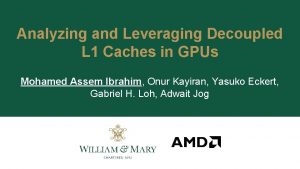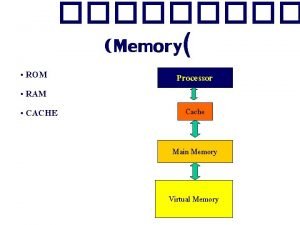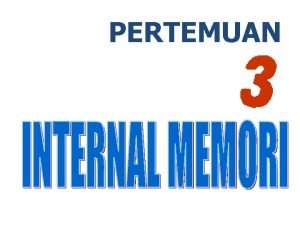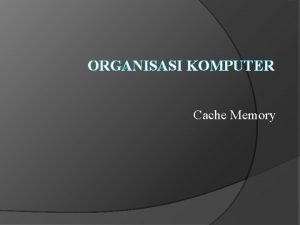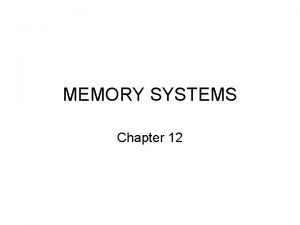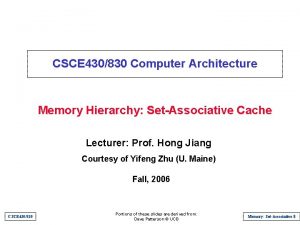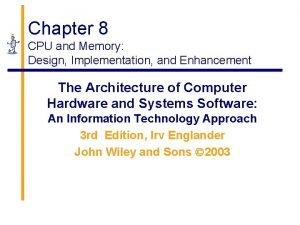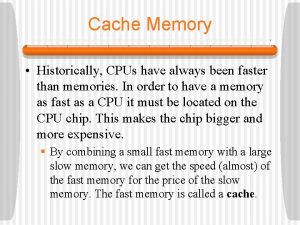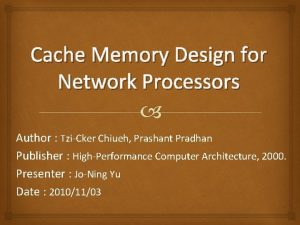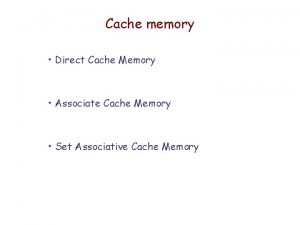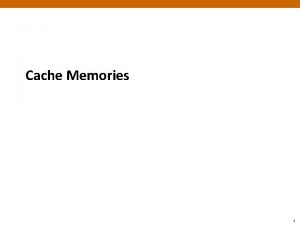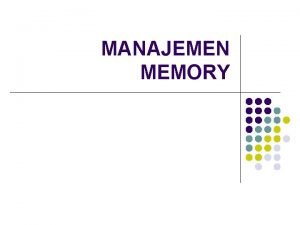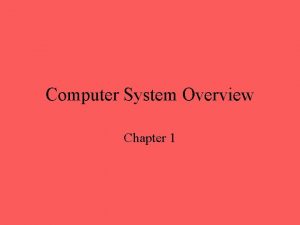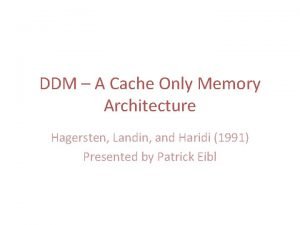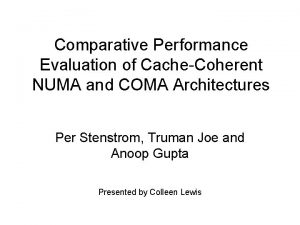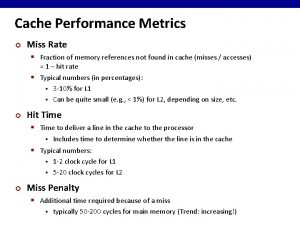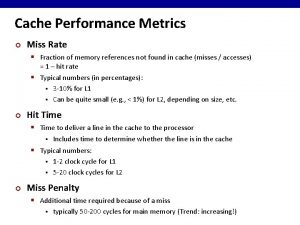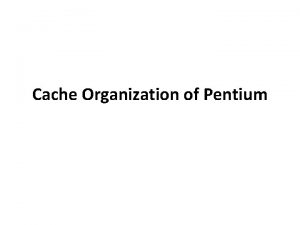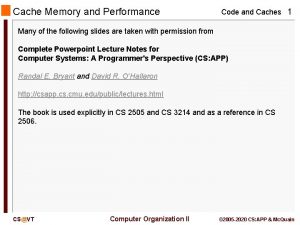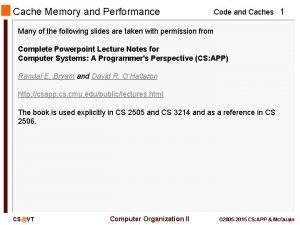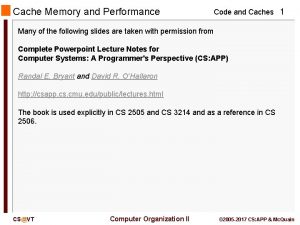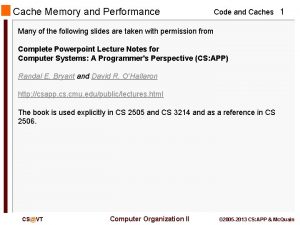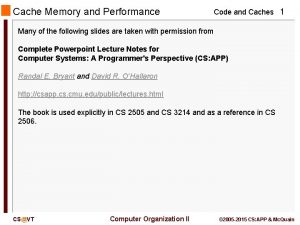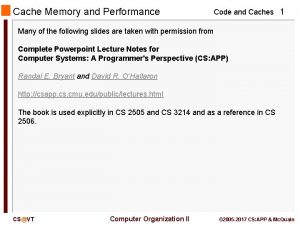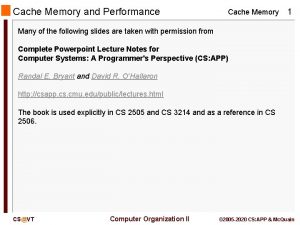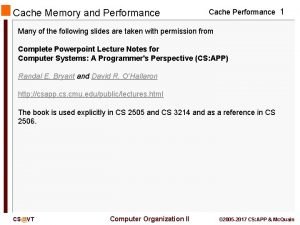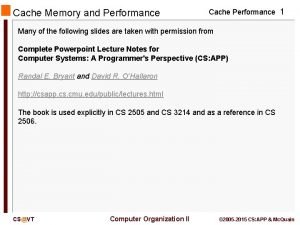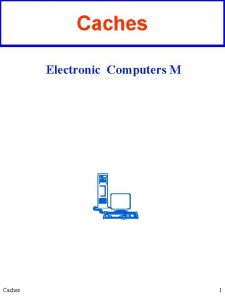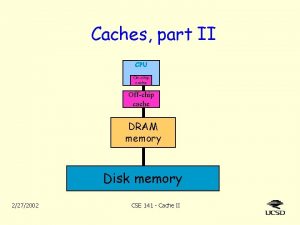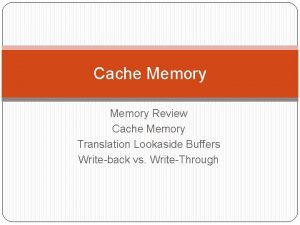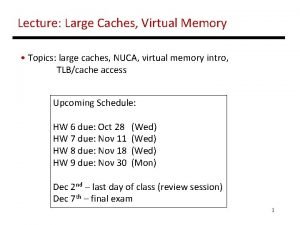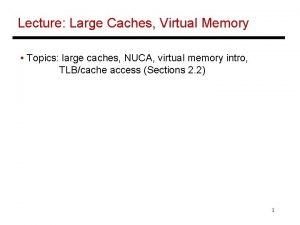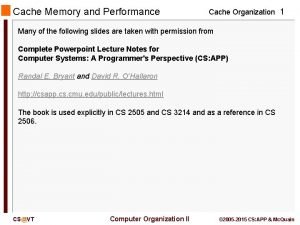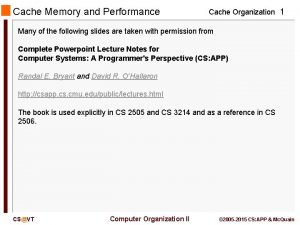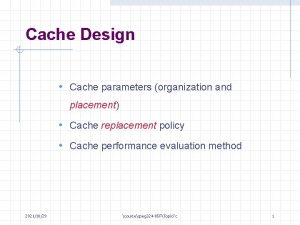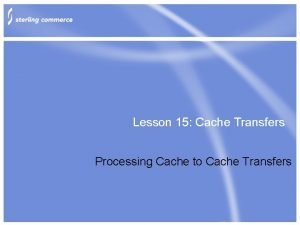Cache Memory and Performance Code and Caches 1




![Layout of C Arrays in Memory int 32_t A[3][5] = { { 0, 1, Layout of C Arrays in Memory int 32_t A[3][5] = { { 0, 1,](https://slidetodoc.com/presentation_image_h2/aab0d128f84cc906a73a1297269d2804/image-5.jpg)
![Layout of C Arrays in Memory int 32_t A[3][5] = { { 0, 1, Layout of C Arrays in Memory int 32_t A[3][5] = { { 0, 1,](https://slidetodoc.com/presentation_image_h2/aab0d128f84cc906a73a1297269d2804/image-6.jpg)




![Layout of C Arrays in Memory Code and Caches 11 int B[3][5] = {. Layout of C Arrays in Memory Code and Caches 11 int B[3][5] = {.](https://slidetodoc.com/presentation_image_h2/aab0d128f84cc906a73a1297269d2804/image-11.jpg)
![Layout of C Arrays in Memory Code and Caches 12 int C[2][3][5] = {. Layout of C Arrays in Memory Code and Caches 12 int C[2][3][5] = {.](https://slidetodoc.com/presentation_image_h2/aab0d128f84cc906a73a1297269d2804/image-12.jpg)















- Slides: 27

Cache Memory and Performance Code and Caches 1 Many of the following slides are taken with permission from Complete Powerpoint Lecture Notes for Computer Systems: A Programmer's Perspective (CS: APP) Randal E. Bryant and David R. O'Hallaron http: //csapp. cs. cmu. edu/public/lectures. html The book is used explicitly in CS 2505 and CS 3214 and as a reference in CS 2506. CS@VT Computer Organization II © 2005 -2013 CS: APP & Mc. Quain

Locality Example (1) Claim: Code and Caches 2 Being able to look at code and get a qualitative sense of its locality is a key skill for a professional programmer. Question: Which of these functions has good locality? int sumarrayrows(int a[M][N]) { int i, j, sum = 0; for (i = 0; i < M; i++) for (j = 0; j < N; j++) sum += a[i][j]; return sum; } int sumarraycols(int a[M][N]) { int i, j, sum = 0; for (j = 0; j < N; j++) for (i = 0; i < M; i++) sum += a[i][j]; return sum; } CS@VT Computer Organization II © 2005 -2013 CS: APP & Mc. Quain

Layout of C Arrays in Memory C arrays allocated in contiguous memory locations with addresses ascending with the array index: int 32_t A[20] = {0, 1, 2, 3, 4, . . . , 8, 9}; CS@VT Computer Organization II Code and Caches 3 80430000 0 80430004 1 80430008 2 8043000 C 3 80430010 4 . . . 80430048 8 8043004 C 9 © 2005 -2013 CS: APP & Mc. Quain

Layout of C Arrays in Memory Two-dimensional C arrays allocated in row-major order each row in contiguous memory locations: int 32_t A[3][5] = { { 0, 1, 2, 3, 4}, {10, 11, 12, 13, 14}, {20, 21, 22, 23, 24}, }; CS@VT Computer Organization II Code and Caches 4 80430000 0 80430004 1 80430008 2 8043000 C 3 80430010 4 80430014 10 80430018 11 8043001 C 12 80430020 13 80430024 14 80430028 20 8043002 C 21 80430030 22 80430034 23 80430038 24 © 2005 -2013 CS: APP & Mc. Quain
![Layout of C Arrays in Memory int 32t A35 0 1 Layout of C Arrays in Memory int 32_t A[3][5] = { { 0, 1,](https://slidetodoc.com/presentation_image_h2/aab0d128f84cc906a73a1297269d2804/image-5.jpg)
Layout of C Arrays in Memory int 32_t A[3][5] = { { 0, 1, 2, 3, 4}, {10, 11, 12, 13, 14}, {20, 21, 22, 23, 24}, }; Code and Caches 5 i = 0 Stepping through columns in one row: for (i = 0; i < 3; i++) for (j = 0; j < 5; j++) sum += A[i][j]; i = 1 - accesses successive elements in memory - if cache block size B > 4 bytes, exploit spatial locality compulsory miss rate = 4 bytes / B CS@VT Computer Organization II i = 2 80430000 0 80430004 1 80430008 2 8043000 C 3 80430010 4 80430014 10 80430018 11 8043001 C 12 80430020 13 80430024 14 80430028 20 8043002 C 21 80430030 22 80430034 23 80430038 24 © 2005 -2013 CS: APP & Mc. Quain
![Layout of C Arrays in Memory int 32t A35 0 1 Layout of C Arrays in Memory int 32_t A[3][5] = { { 0, 1,](https://slidetodoc.com/presentation_image_h2/aab0d128f84cc906a73a1297269d2804/image-6.jpg)
Layout of C Arrays in Memory int 32_t A[3][5] = { { 0, 1, 2, 3, 4}, {10, 11, 12, 13, 14}, {20, 21, 22, 23, 24}, }; Code and Caches 6 j = 0 80430000 0 j = 1 80430004 1 80430008 2 8043000 C 3 80430010 4 80430014 10 80430018 11 8043001 C 12 80430020 13 80430024 14 80430028 20 8043002 C 21 80430030 22 80430034 23 80430038 24 Stepping through rows in one column: for (j = 0; i < 5; i++) for (i = 0; i < 3; i++) sum += a[i][j]; accesses distant elements no spatial locality! compulsory miss rate = 1 (i. e. 100%) CS@VT Computer Organization II © 2005 -2013 CS: APP & Mc. Quain

Code and Caches 7 Writing Cache Friendly Code Repeated references to variables are good (temporal locality) Stride-1 reference patterns are good (spatial locality) 0 1 Assume an initially-empty cache with 16 -byte cache blocks. 2 int sumarrayrows(int a[M][N]) { int i, j, sum = 0; for (i = 0; i < M; i++) for (j = 0; j < N; j++) sum += a[i][j]; return sum; i = 0, j = 0 to i = 0, j = 3 3 4 5 i = 0, j = 4 to i = 1, j = 2 6 7 } Miss rate = 1/4 = 25% CS@VT Computer Organization II © 2005 -2013 CS: APP & Mc. Quain

Writing Cache Friendly Code and Caches 8 "Skipping" accesses down the rows of a column do not provide good locality: int sumarraycols(int a[M][N]) { int i, j, sum = 0; for (j = 0; j < N; j++) for (i = 0; i < M; i++) sum += a[i][j]; return sum; } Miss rate = 100% (That's actually somewhat pessimistic. . . depending on cache geometry. ) CS@VT Computer Organization II © 2005 -2013 CS: APP & Mc. Quain

Locality Example (2) Code and Caches 9 Question: Can you permute the loops so that the function scans the 3 D array a[] with a stride-1 reference pattern (and thus has good spatial locality)? int sumarray 3 d(int a[M][N][N]) { int i, j, k, sum = 0; for (i = 0; i < M; i++) for (j = 0; j < N; j++) for (k = 0; k < N; k++) sum += a[k][i][j]; return sum } CS@VT Computer Organization II © 2005 -2013 CS: APP & Mc. Quain

Layout of C Arrays in Memory Code and Caches 10 It's easy to write an array traversal and see the addresses at which the array elements are stored: int A[5] = {0, 1, 2, 3, 4}; for (i = 0; i < 5; i++) printf("%d: %Xn", i, (unsigned)&A[i]); We see there that for a 1 D array, the index varies in a stride-1 pattern. i address -----0: 28 ABE 0 1: 28 ABE 4 2: 28 ABE 8 3: 28 ABEC 4: 28 ABF 0 CS@VT stride-1 : addresses differ by the size of an array cell (4 bytes, here) Computer Organization II © 2005 -2013 CS: APP & Mc. Quain
![Layout of C Arrays in Memory Code and Caches 11 int B35 Layout of C Arrays in Memory Code and Caches 11 int B[3][5] = {.](https://slidetodoc.com/presentation_image_h2/aab0d128f84cc906a73a1297269d2804/image-11.jpg)
Layout of C Arrays in Memory Code and Caches 11 int B[3][5] = {. . . }; for (i = 0; i < 3; i++) for (j = 0; j < 5; j++) printf("%d %3 d: %Xn", i, j, (unsigned)&B[i][j]); We see that for a 2 D array, the second index varies in a stride-1 pattern. But the first index does not vary in a stride-1 pattern. j-i order: i-j order: i j address --------0 0: 28 ABA 4 0 1: 28 ABA 8 0 2: 28 ABAC 0 3: 28 ABB 0 0 4: 28 ABB 4 1 0: 28 ABB 8 1 1: 28 ABBC 1 2: 28 ABC 0 CS@VT stride-1 i j address --------0 0: 28 CC 9 C stride-5 (0 x 14/4) 1 0: 28 CCB 0 2 0: 28 CCC 4 0 1: 28 CCA 0 1 1: 28 CCB 4 2 1: 28 CCC 8 0 2: 28 CCA 4 1 2: 28 CCB 8 Computer Organization II © 2005 -2013 CS: APP & Mc. Quain
![Layout of C Arrays in Memory Code and Caches 12 int C235 Layout of C Arrays in Memory Code and Caches 12 int C[2][3][5] = {.](https://slidetodoc.com/presentation_image_h2/aab0d128f84cc906a73a1297269d2804/image-12.jpg)
Layout of C Arrays in Memory Code and Caches 12 int C[2][3][5] = {. . . }; for (i = 0; i < 2; i++) for (j = 0; j < 3; j++) for (k = 0; k < 5; k++) printf("%3 d %3 d: %dn", i, j, k, (unsigned)&C[i][j][k]); We see that for a 3 D array, the third index varies in a stride-1 pattern: But… if we change the order of access, we no longer have a stride-1 pattern: i-j-k order: k-j-i order: i-k-j order: i j k address ---------0 0 0: 28 CC 1 C 0 0 1: 28 CC 20 0 0 2: 28 CC 24 0 0 3: 28 CC 28 0 0 4: 28 CC 2 C 0 1 0: 28 CC 30 0 1 1: 28 CC 34 0 1 2: 28 CC 38 i j k address ---------0 0 0: 28 CC 24 1 0 0: 28 CC 60 0 1 0: 28 CC 38 1 1 0: 28 CC 74 0 2 0: 28 CC 4 C 1 2 0: 28 CC 88 0 0 1: 28 CC 28 1 0 1: 28 CC 64 i j k address ---------0 0 0: 28 CC 24 0 1 0: 28 CC 38 0 2 0: 28 CC 4 C 0 0 1: 28 CC 28 0 1 1: 28 CC 3 C 0 2 1: 28 CC 50 0 0 2: 28 CC 2 C 0 1 2: 28 CC 40 CS@VT Computer Organization II © 2005 -2013 CS: APP & Mc. Quain

Locality Example (2) Code and Caches 13 Question: Can you permute the loops so that the function scans the 3 D array a[] with a stride-1 reference pattern (and thus has good spatial locality)? int sumarray 3 d(int a[M][N][N]) { int i, j, k, sum = 0; for (i = 0; i < M; i++) for (j = 0; j < N; j++) for (k = 0; k < N; k++) sum += a[k][i][j]; return sum } This code does not yield good locality at all. The inner loop is varying the first index, worst case! CS@VT Computer Organization II © 2005 -2013 CS: APP & Mc. Quain

Code and Caches 14 Locality Example (3) Question: Which of these two exhibits better spatial locality? // struct of arrays struct soa { float *x; float *y; float *z; float *r; }; // array of structs struct aos { float x; float y; float z; float r; }; compute_r(struct soa s) { for (i = 0; …) { s. r[i] = s. x[i] * s. x[i] + s. y[i] * s. y[i] + s. z[i] * s. z[i]; } } compute_r(struct aos *s) { for (i = 0; …) { s[i]. r = s[i]. x * s[i]. x + s[i]. y * s[i]. y + s[i]. z * s[i]. z; } } CS@VT Computer Organization II © 2005 -2013 CS: APP & Mc. Quain

Code and Caches 15 Locality Example (3) // struct of arrays struct soa { float *x; float *y; float *z; float *r; }; struct soa s; s. x = malloc(8*sizeof(float)); . . . x y z r 16 bytes // array of structs struct aos { float x; float y; float r; }; struct aos s[8]; x x x x y y y y z z z z r r r r 32 bytes each 16 bytes each CS@VT Computer Organization II © 2005 -2013 CS: APP & Mc. Quain

Code and Caches 16 Locality Example (3) Question: Which of these two exhibits better spatial locality? // struct of arrays compute_r(struct soa s) { for (i = 0; …) { s. r[i] = s. x[i] * s. x[i] + s. y[i] * s. y[i] + s. z[i] * s. z[i]; } } x y z r CS@VT // array of structs compute_r(struct aos *s) { for (i = 0; …) { s[i]. r = s[i]. x * s[i]. x + s[i]. y * s[i]. y + s[i]. z * s[i]. z; } } x x x x y y y y z z z z r r r r Computer Organization II © 2005 -2013 CS: APP & Mc. Quain

Code and Caches 17 Locality Example (4) Question: Which of these two exhibits better spatial locality? // struct of arrays sum_r(struct soa s) { sum = 0; for (i = 0; …) { sum += s. r[i]; } } x y z r CS@VT // array of structs sum_r(struct aos *s) { sum = 0; for (i = 0; …) { sum += s[i]. r; } } x x x x y y y y z z z z r r r r Computer Organization II © 2005 -2013 CS: APP & Mc. Quain

Code and Caches 18 Locality Example (5) QTP: How would this compare to the previous two? // array of pointers to structs struct aos { float x; float y; float z; float r; }; struct aops[8]; for (i = 0; i < 8; i++) apos[i] = malloc(sizeof(struct aops)); CS@VT Computer Organization II © 2005 -2013 CS: APP & Mc. Quain

Writing Cache Friendly Code and Caches 19 Make the common case go fast – Focus on the inner loops of the core functions Minimize the misses in the inner loops – – Repeated references to variables are good (temporal locality) Stride-1 reference patterns are good (spatial locality) Key idea: Our qualitative notion of locality is quantified through our understanding of cache memories. CS@VT Computer Organization II © 2005 -2013 CS: APP & Mc. Quain

Miss Rate Analysis for Matrix Multiply Code and Caches 20 Assume: Line size = 32 B (big enough for four 64 -bit words) Matrix dimension (N) is very large Approximate 1/N as 0. 0 Cache is not even big enough to hold multiple rows Analysis Method: Look at access pattern of inner loop j k i i k A CS@VT j B Computer Organization II C © 2005 -2013 CS: APP & Mc. Quain

Matrix Multiplication Example Code and Caches 21 Description: Multiply N x N matrices O(N 3) total operations N reads per source element N values summed per destination Variable sum /* ijk */ held in register for (i=0; i<n; i++) { for (j=0; j<n; j++) { sum = 0. 0; for (k=0; k<n; k++) sum += a[i][k] * b[k][j]; c[i][j] = sum; } } CS@VT Computer Organization II © 2005 -2013 CS: APP & Mc. Quain

Matrix Multiplication (ijk) Code and Caches 22 /* ijk */ for (i=0; i<n; i++) { for (j=0; j<n; j++) { sum = 0. 0; for (k=0; k<n; k++) sum += a[i][k] * b[k][j]; c[i][j] = sum; } } Misses per inner loop iteration: A B 0. 25 1. 0 CS@VT Inner loop: (*, j) (i, *) A B Row-wise Columnwise (i, j) C Fixed C 0. 0 Computer Organization II © 2005 -2013 CS: APP & Mc. Quain

Matrix Multiplication (kij) Code and Caches 23 /* kij */ for (k=0; k<n; k++) { for (i=0; i<n; i++) { r = a[i][k]; for (j=0; j<n; j++) c[i][j] += r * b[k][j]; } } Misses per inner loop iteration: A B 0. 0 0. 25 CS@VT Inner loop: (i, k) A Fixed (k, *) B (i, *) C Row-wise C 0. 25 Computer Organization II © 2005 -2013 CS: APP & Mc. Quain

Matrix Multiplication (jki) Code and Caches 24 /* jki */ for (j=0; j<n; j++) { for (k=0; k<n; k++) { r = b[k][j]; for (i=0; i<n; i++) c[i][j] += a[i][k] * r; } } Misses per inner loop iteration: A B 1. 0 0. 0 CS@VT Inner loop: (*, k) (*, j) (k, j) A B C Columnwise Fixed Columnwise C 1. 0 Computer Organization II © 2005 -2013 CS: APP & Mc. Quain

Code and Caches 25 Summary of Matrix Multiplication for (i=0; i<n; i++) { for (j=0; j<n; j++) { sum = 0. 0; for (k=0; k<n; k++) sum += a[i][k] * b[k][j]; c[i][j] = sum; } } for (k=0; k<n; k++) { for (i=0; i<n; i++) { r = a[i][k]; for (j=0; j<n; j++) c[i][j] += r * b[k][j]; } } kij (& ikj): • 2 loads, 1 store • misses/iter = 0. 5 for (j=0; j<n; j++) { for (k=0; k<n; k++) { r = b[k][j]; for (i=0; i<n; i++) c[i][j] += a[i][k] * r; } } CS@VT ijk (& jik): • 2 loads, 0 stores • misses/iter = 1. 25 jki (& kji): • 2 loads, 1 store • misses/iter = 2. 0 Computer Organization II © 2005 -2013 CS: APP & Mc. Quain

Core i 7 Matrix Multiply Performance Code and Caches 26 60 Cycles per inner loop iteration jki / kji 50 40 jki kji ijk jik 30 ijk / jik 20 10 kij / ikj 0 50 100 150 200 250 300 350 400 450 500 550 600 650 700 750 Array size (n) CS@VT Computer Organization II © 2005 -2013 CS: APP & Mc. Quain

Concluding Observations Code and Caches 27 Programmer can optimize for cache performance How data structures are organized How data are accessed Nested loop structure Blocking is a general technique All systems favor “cache friendly code” Getting absolute optimum performance is very platform specific Cache sizes, line sizes, associativities, etc. Can get most of the advantage with generic code Keep working set reasonably small (temporal locality) Use small strides (spatial locality) CS@VT Computer Organization II © 2005 -2013 CS: APP & Mc. Quain
 Page fault
Page fault Analyzing and leveraging decoupled l1 caches in gpus
Analyzing and leveraging decoupled l1 caches in gpus L caches
L caches Ramcache
Ramcache Merits and demerits of direct mapping
Merits and demerits of direct mapping Karakteristik memori
Karakteristik memori Karakteristik dari cache memory
Karakteristik dari cache memory Direct mapped cache
Direct mapped cache Cache vs memory
Cache vs memory Set associative mapping in cache memory
Set associative mapping in cache memory Cache vs memory
Cache vs memory Cache memory is faster than
Cache memory is faster than Cache memory design
Cache memory design Karakteristik write through didalam write policy
Karakteristik write through didalam write policy Set associative cache
Set associative cache Cache memory organization
Cache memory organization Contoh memori register
Contoh memori register Cache memory is invisible to the os
Cache memory is invisible to the os Cache only memory architecture
Cache only memory architecture Cache only memory architecture
Cache only memory architecture Cache performance metrics
Cache performance metrics Cache performance metrics
Cache performance metrics Code commit code build code deploy
Code commit code build code deploy Explain cache organization of pentium processor
Explain cache organization of pentium processor Graalvm python
Graalvm python Internal memory and external memory
Internal memory and external memory Primary memory and secondary memory
Primary memory and secondary memory Episodic memory
Episodic memory

